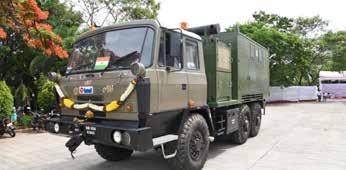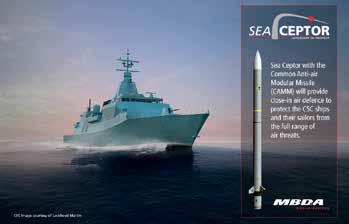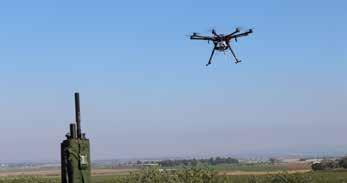
11 minute read
Raytheon Group Companies send life-saving machines to India
Raytheon Technologies Corporation which employs nearly 5,000 people in India, primarily through Pratt & Whitney and Collins Aerospace, is acting to support the nation during the challenging second wave of COVID-19 cases and protect the health of its colleagues, their families and communities.
The company is donating 1,000 oxygen concentrators that have already started arriving in India, through the U.S.India Strategic Partnership Forum and organizations actively working with the government across the country. These life-saving devices will be distributed where the need is the greatest, including those communities where our employees work and live. RTX will continue to explore ways to partner and support impacted communities as India recovers.
Advertisement
“Although there are signs of recovery in many parts of the world, our teammates in India continue to confront the enormous challenges of the pandemic,” said Pam Erickson, chief communications officer for Raytheon Technologies. “The time for us to act is now.”
“We need a global response to tackle India’s second wave of COVID-19 infections. The aerospace industry has been on the frontlines, with our military and airline customers transporting vaccines, oxygen and medicines with urgency,” said Ashmita Sethi, president & country head, Pratt & Whitney. “We are proud to power their efforts, and help directly in this time of crisis.”
Teams across RTX are also actively working on securing resources, and utilizing supply chain capabilities to provide PPE and other essential supplies for employees and local communities. Raytheon Technologies will be matching employee donations made through May 22, which will be channeled to several nonprofits supporting COVID-19 relief efforts in India.
Pratt & Whitney has a proud seventy year legacy of supporting India’s aviation growth across commercial, regional and military aviation. With over 680 turboprop, turboshaft and turbofan aircraft, Pratt & Whitney has the largest footprint of any engine maker in the country, and one in every two people flying in India, fly on planes powered by Pratt & Whitney engines.
Through its businesses, Raytheon Technologies has been investing in India for decades. Together, RTX companies Pratt & Whitney, Collins Aerospace, Raytheon Intelligence & Space and Raytheon Missiles & Defense are actively involved in ‘Make in India’ with their design, engineering and MRO centers – and ‘Skill India’ through their training center and STEM education initiatives.
Pratt & Whitney, a unit of Raytheon Technologies (NYSE:RTX) is a world leader in the design, manufacture and service of aircraft and helicopter engines, and auxiliary power units. Raytheon Technologies Corporation is an aerospace and defense company that provides advanced systems and services for commercial, military and government customers worldwide.
AEROMAG ASIA, Aeronautical Society of India Building, Suranjandas Road, Off Old Madras Road, Bangalore - 560075, Karnataka, India.


BEML Limited, one of the leading public sectors under Ministry of Defence, has rolled out the first prototype of Mechanical Minefield Marking Equipment Mk-II, built on BEML TATRA 6x6, an ‘Atmanirbhar’ product, developed through TOT from R&D E Engineers, DRDO.
The virtual roll out was performed in the presence of M V Rajasekar, CMD, BEML and V. V. Parliker, Director, R&D (Engrs), DRDO. Also present were Kiran Jadhav, CMD Accurate Group, other partners from Dynalog (India) Ltd, Electro-Pneumatics & Hydraulics (I) Pvt Ltd and Adroit System Pvt Ltd and BEML team headed by AK Srivastav, Director, Defence.
BEML signed LAToT during the ‘Bandhan’ event in presence of Defence Minister during DEFEXPO 2020 and is executing the project by partnering with number of MSMEs.
Mechanical Minefield Marking Equipment MK-II developed by R&DE (Engineers) would greatly benefit Indian army to mark/fence minefields. The MK II is designed for marking the mine fields at faster rate, semi-automatically with minimal human intervention.
The equipment is capable of marking/fencing at a minimum rate of 1.2 km/hr with inter-picket spacing of 15 m. The system has capability to place the pickets at 10 – 35 meters spacing in the step of 5 m. The picket can be driven to a maximum depth of 450 mm by this system.
MMME Mk-II system is designed to operate in plains of Punjab, as well as semi-desert & desert of Rajasthan, in all weather conditions. The system can store 500 numbers of pickets and polypropylene rope of 15 km in length.
The main sub systems which are to be integrated on to the vehicle are Carrier vehicle, Mechanical sub system, Pneumatic sub system, Electrical sub system and Electronic sub system with selected sub-vendors. Sourcing of subsystem from industries established during development phase is being followed by BEML. The superstructure is being built by sub-vendors and supplying to Accurate Group for integration onto BEML HMV.
M.V. Rajashekar, CMD, BEML said, ”We are proud to be a partner with this project in our quest to achieve ‘Atmanirbhrata’. The equipment will greatly benefit the Indian Army during operations. I am sure that this project would be the harbinger for many more projects to come.”
BEML is expected to receive the orders of more than 55 systems from MoD after the successful trial evaluation.
DRDO conducts maiden trial of Python-5 Air to Air Missile

Tejas, India's indigenous Light Combat Aircraft, added the 5th generation Python-5 Air-to-Air Missile (AAM) in its air-to-air weapons capability on April 27, 2021. Trials were also aimed to validate enhanced capability of already integrated Derby Beyond Visual Range (BVR) AAM on Tejas. The test firing at Goa completed a series of missile trials to validate its performance under extremely challenging scenarios. Derby missile achieved direct hit on a high-speed maneuvering aerial target and the Python missiles also achieved 100% hits, thereby validating their complete capability. The trials met all their planned objectives.
Prior to these trials, extensive missile carriage flight tests were conducted at Bengaluru to assess integration of the missile with aircraft systems on board the Tejas, like Avionics, Fire-control radar, Missile Weapon Delivery System and the Flight Control System. At Goa, after successful separation trials, live launch of the missile on a Banshee target was carried out. Python-5 missile live firing was conducted to validate target engagement from all aspects as well as beyond visual ranges. In all the live firings, missile hit the aerial target.
The missiles were fired from Tejas aircraft of Aeronautical Development Agency (ADA) flown by Indian Air Force (IAF) Test pilots belonging to National Flight Test Centre (NFTC). The successful conduct was made possible with years of hard work by the team of scientists, engineers, and technicians from ADA and HAL-ARDC along with admirable support from CEMILAC, DGAQA, IAF PMT, NPO (LCA Navy) and INS HANSA.
Defence Minister Rajnath Singh has congratulated the teams of DRDO, ADA, Indian Air Force, HAL and all involved in the trial. Secretary Department of Defence R&D and Chairman DRDO Dr G Satheesh Reddy appreciated the efforts of scientists, engineers and technicians from various organizations and industry.
MBDA’s Sea Ceptor ordered for Canadian Surface Combatant

MBDA has been awarded a contract by Lockheed Martin Canada to equip the Royal Canadian Navy's new Canadian Surface Combatant (CSC) with the Sea Ceptor air defence weapon system.
Utilising the Common Anti-air Modular Missile (CAMM) as its effector, Sea Ceptor will undertake the Close-In Air Defence System (CIADS) role on-board the new CSC frigates.
Sea Ceptor provides exceptional self-defence performance, with a rapid response time and a high rate of fire to defeat multiple threats simultaneously. Its state-of-the-art Soft Vertical Launch (SVL) technology enables full 360° coverage with close range performance normally only associated with trainable launcher systems. Sea Ceptor will be integrated with Lockheed Martin Canada’s Combat Management System 330 (CMS 330) as part of a multi-tier air defence capability. The CAMM missiles will be quad packed in Lockheed Martin’s Extensible Launcher System (ExLS), which is part of the Mk41 family of vertical launcher systems.
MBDA’s role on CSC will create a positive impact on the Canadian defence industry and its supply chain through Canada’s Industrial and Technological Benefits (ITB) policy. This contract will bring significant investment by MBDA in research and development to Canada across a wide range of technologies, such as artificial intelligence, cyber security and advanced materials. This investment will be made across small and medium-sized enterprises (SMEs), academia and other key industries across Canada, supporting high technology jobs. In addition, the CSC program will further strengthen the partnership between MBDA and Lockheed Martin Canada, which has already seen Sea Ceptor and CMS330 providing world-class air defence capabilities to the Royal New Zealand Navy and the Chilean Navy.
Éric Béranger, CEO of MBDA, said: “We are delighted to be awarded this contract, and to play a part in contributing to such an important programme to Canada. Sea Ceptor delivers next generation technology that will help protect the men and women of the Royal Canadian Navy as they carry out their missions around the world on-board the advanced new CSC frigates.”
UK Defence Minister opens New Boxer Armoured Vehicle Production Facility

UK Minister for Defence Procurement, Jeremy Quin, has visited WFEL to formally open the new Boxer Armoured Vehicle Production Facility, in advance of first-stage production commencement. This new facility in Stockport will play a significant role in the manufacture of the Boxer, the British Army’s latest armoured vehicle.
During his visit, the Minister saw first-hand the newly built production line and met with WFEL personnel who will be working directly on the state-of-the art vehicles. He also met with WFEL Apprentices and heard about the latest developments in the roll-out of the UK supply chain for the Boxer programme.
Speaking at the event, Minister Quin said: “Our Boxer programme is playing a significant role in boosting prosperity, supporting skills, protecting over 1,000 jobs across the North West, North East, West Midlands, central Scotland, Wales and throughout the UK wider supply chain.
“This new production line is creating 120 new jobs at WFEL, further cementing our investment in UK innovation and expertise.” The Minister also had the opportunity to see a live demonstration of the latest Boxer variant - the Boxer Bridgelayer - which incorporates bridge sections manufactured by WFEL personnel in Stockport.
Ian Anderton, WFEL's Managing Director, commented, "We were honoured that the UK Defence Minister was able to visit us, to see the progress already made in this significant, new, armoured vehicle programme for the British Army. In spite of the restrictions caused by the COVID pandemic, our teams have succeeded in keeping us on schedule and we are now poised to begin production. We look forward to delivering the first vehicles to the Army in due course".
DRDO develops Advanced Chaff Technology to safeguard naval ships from missile attack

Defence Research and Development Organisation (DRDO) has developed an Advanced Chaff Technology to safeguard the naval ships against enemy missile attack. Defence Laboratory Jodhpur (DLJ), a DRDO laboratory, has indigenously developed three variants of this critical technology namely Short Range Chaff Rocket (SRCR), Medium Range Chaff Rocket (MRCR) and Long Range Chaff Rocket (LRCR) meeting Indian Navy’s qualitative requirements. The successful development of Advanced Chaff Technology by DLJ is another step towards Atmanirbhar Bharat.
Recently, Indian Navy conducted trials of all three variants in the Arabian Sea on Indian Naval Ship and found the performance satisfactory.
Chaff is a passive expendable electronic countermeasure technology used worldwide to protect naval ships from enemy’s radar and Radio Frequency (RF) missile seekers. The importance of this development lies in the fact that very less quantity of chaff material deployed in the air acts as decoy to deflect enemy’s missiles for safety of the ships.
The DRDO has gained the expertise to meet the futuristic threats from adversaries. The technology is being given to the industry for production in large quantities.
Defence Minister Rajnath Singh has congratulated DRDO, Indian Navy and Industry for the achievement.
Secretary Department of Defence R&D & Chairman DRDO Dr G Satheesh Reddy appreciated the efforts of the teams involved in the indigenous development of this vital technology to safeguard Indian Naval Ships.
Vice Chief of Naval Staff Vice Admiral G Ashok Kumar has applauded DRDO efforts in developing strategically important technology indigenously in a short span and cleared for bulk production.
IAI to Provide the Z-MAG All-Terrain Vehicle to Israel’s MOD for IDF Maneuvering Units

Israeli MOD Department of Production and Procurement and IAI Sign First Agreement to Manufacture Z-MAG For IDF and Global Customers.
Israel Aerospace Industries (IAI) and Israel’s Ministry of Defense (MOD) Office of Production and Procurement have signed an agreement to manufacture the Z-MAG, a unique allterrain vehicle for the Israel Defense Forces (IDF).
IAI has recently acquired the rights to the Israeli Z offroad vehicle family. Israel’s MOD Sub Department for Land Production and Procurement and IAI’s ELTA Group signed an agreement to manufacture and supply nine Z-MAG all-terrain vehicles to the IDF, with an option to order 21 additional units.
The Israeli developed Z-MAG vehicles have been a point of interest in the local and global off-road, all-terrain vehicle community. The Z-MAG has an exceptional ability to maneuver in the most extreme topographical conditions and terrain. The first Z-MAG vehicles purchased by MOD will feature unique capabilities designed especially for the needs of the IDF’s Maneuvering Units. Following an assessment period, the IDF will consider buying more vehicles in the coming years. IAI is building an assembly line for the Z vehicles to be housed at ELTA’s Land Division in Be’er Sheba and is investing ILS 100 million in the project.
Yoav Turgeman, IAI VP and CEO of ELTA, said, “IAI is proud to supply the world’s most advanced all-terrain vehicles, developed in Israel, to Israel's defense community. ELTA develops and produces a broad range of products for land purposes, including: surveillance, autonomous robotics, remote sensing, and communication. By integrating these capabilities in the Z vehicle family our products provide added value to the forces’ operational possibilites, be it in defense, assault or homeland security intelligence gathering.”










